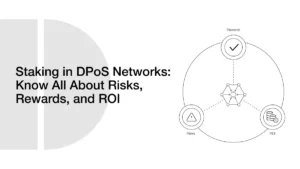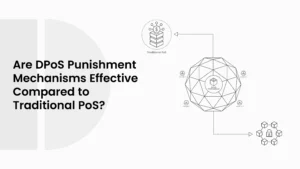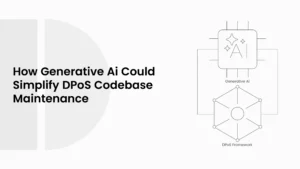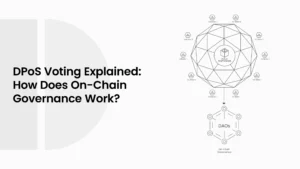From Elections to Blockchain: How DPoS Works in the Real World
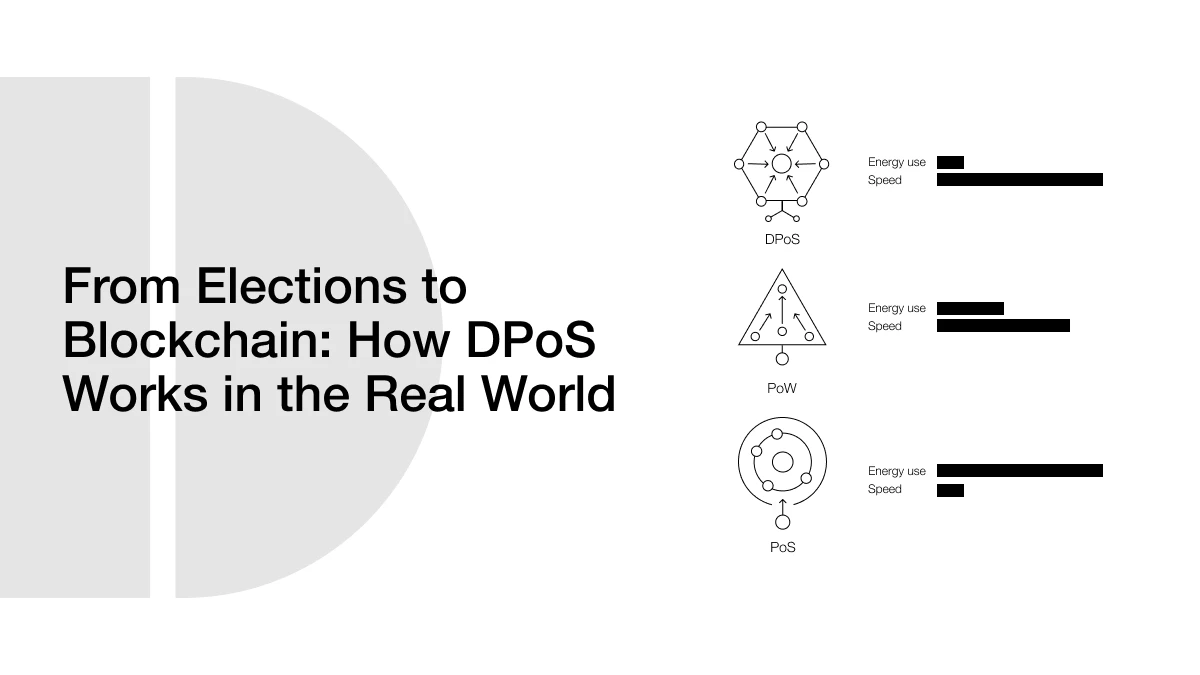
A technology known as blockchain was developed to monitor and verify online transactions through a decentralized network of computers. These systems require a method to ensure that all participants consent to the validity of transactions, allowing them to function without a central authority. This method serves as a consensus mechanism.
- What Is DPoS?
- Why Choose DPoS Over PoW and PoS?
- The Advantages of DPoS: Efficiency, Speed, and Scalability
- The Disadvantages of DPoS: Centralisation and Security Concerns
- Practical Examples for High School Learners
- Top Blockchains Using DPoS
- The Key Takeaway
- Frequently Asked Questions (FAQs)
- Glossary of Key Terms
The consensus mechanism known as Delegated Proof of Stake (DPoS) has gained interest due to its efficiency, speed, and scalability. A governance model known as DPoS employs delegated voting to enhance community participation and is more efficient in resource usage compared to Proof of Work (PoW) systems. Using familiar examples and clear language, this article aims to demonstrate the benefits, drawbacks, and possible trade-offs of DPoS.
What Is DPoS?
| Mechanism | How It Works | Energy Use | Speed |
| PoW (Proof of Work) | Miners solve puzzles to validate transactions. | High | Slow |
| PoS (Proof of Stake) | Validators are chosen based on staked tokens. | Moderate | Faster |
| DPoS (Delegated PoS) | Voters elect block producers to validate. | Low | Fastest |
Delegation is incorporated into the voting mechanism through a consensus approach known as Delegated Proof of Stake (DPoS). DPoS is a more organized and representative method than traditional Proof of Stake (PoS), which selects validators based on token ownership, and Proof of Work (PoW), which requires computer capacity.
In a Delegated Proof of Stake (DPoS) system, individuals select a small group of trusted users, known as delegates or block producers, to assist in running the blockchain and maintaining its security. The more coins someone owns, the more voting power they usually have. These chosen block producers take turns adding new blocks to the blockchain, which helps make transactions fast and smooth.
ALSO READ: Is DPoS the Future of Scalable Governance in Blockchain?
Several high-performance blockchain networks, including EOS, TRON, and Steem, are based on this methodology. According to EOS, the architecture was presented to “support industrial-scale applications” by fusing low-latency block creation with democratic governance.
Why Choose DPoS Over PoW and PoS?
| Feature | Proof of Work (PoW) | Proof of Stake (PoS) | Delegated Proof of Stake (DPoS) |
| Energy Consumption | Very High (e.g., Bitcoin mining) | Moderate (no mining needed) | Low (few nodes validate) |
| Scalability | Limited (slow transaction times) | Better than PoW | Highly Scalable (blocks every few seconds) |
| Transaction Speed | Slow (10+ minutes per block) | Moderate to Fast | Very Fast (as low as 0.5 seconds per block) |
| Network Participation | Anyone with enough hardware | Anyone with enough stake | Anyone can vote; few validate |
| Environmental Impact | Negative (heavy electricity use) | Neutral to Moderate | Positive (minimal resource usage) |
| Governance Style | None / off-chain | Somewhat on-chain | Built-in on-chain democracy |
| Decentralization Risk | Low (many miners) | Medium (rich holders dominate) | Medium–High (small group of delegates) |
| Best Use Case | Security-focused blockchains | Flexible applications | High-throughput & eco-conscious platforms |
The Advantages of DPoS: Efficiency, Speed, and Scalability
The speed, energy economy, and scalable architecture of DPoS are among its most frequently mentioned benefits. By limiting the number of block producers who can validate transactions, DPoS removes the need for extensive computational work. Comparing this to more conventional models, such as PoW, the confirmation times are noticeably faster.
Additionally, the system supports DPOS scalability, enabling it to handle high user and transaction volumes. For example, in optimal circumstances, systems like EOS have claimed to be able to process hundreds of transactions per second; this throughput is made feasible by larger block sizes and a simplified validator schedule.
The democratic aspect of government is an additional advantage. Users actively choose and replace block producers rather than being passive players. Because network control is influenced by the broader community rather than a specific group of actors, this strengthens responsibility and promotes a certain degree of decentralization.
Bitcoin and numerous Proof of Work (PoW) networks consume massive electricity, often exceeding that of entire countries like Argentina or the Netherlands. This is owing to thousands of miners, each armed with powerful equipment, continually competing to solve difficult challenges. Delegated Proof of Stake (DPoS) dramatically reduces energy consumption by restricting transaction validation to a predetermined set of nodes.
The Disadvantages of DPoS: Centralisation and Security Concerns
Despite its strengths, DPoS has its limitations. Prominent among the disadvantages of DPoS are issues relating to centralization risks and security vulnerabilities. Since only a small number of block producers are active at any given time, there is an inherent risk that power may become concentrated among a few dominant stakeholders.
A lack of voter turnout, vote buying, or delegate cooperation can all increase the likelihood of centralization in DPoS. The EOS whitepaper states that although token holders can vote, low turnout could lead to the same organizations holding onto power for extended periods, undermining the model’s decentralized goal.
DPOS security is another factor to consider. Block producers have the power to restrict legitimate transactions or change transaction history if the bulk of them behave dishonestly. The arrangement nonetheless invests a great deal of faith in a small number of actors, even while the possibility of being voted out serves as a disincentive. Additionally, because blockmakers’ identities are frequently known, they could be influenced or pressured by outside parties.
ALSO READ: How to Delegate Tokens on a DPoS Blockchain (Step-by-Step Guide)
These structural weaknesses, while not inherent failures, illustrate the importance of continuous governance improvements and incentive realignment in DPoS systems.
Practical Examples for High School Learners
| DPoS Element | High School Analogy |
| Token Holders | All students in the school |
| Block Producers | Elected student council members |
| Voting | School-wide student elections |
| Delegation | Voting for someone to make decisions for you |
| Consensus | Council decisions that reflect school interests |
Delegated Proof of Stake (DPoS) is such that it might not be easy to understand in the absence of real examples. On the other hand, comparing it with the actual events and creating differences in it may help explain it, particularly at involving high school level. DPoS is essentially a mechanism where token holders delegate a select group of individuals, referred to as block producers, to confirm transactions and manage the blockchain. This approach, similar to student council elections, involves a small group of elected students who represent the opinions of the entire student body.
A concrete example of DPoS in action is the EOS blockchain, which operates with 21 elected block producers at any given time. In 2019, EOS faced criticism over concerns about centralization when it was alleged that a few block producers had formed alliances to maintain their positions. Reports revealed cases of vote trading, where certain producers offered financial incentives in exchange for votes.
This influenced the notion of decentralization negatively and garnered a great deal of negative attention for the society. The situation can be compared to one observed among high school students, wherein a given category of students consistently wins elections in classes not based on merit, but rather by offering incentives to voters, a most unjust and non-representative process.
The TRON network, which is also based on DPoS, however, demonstrates how the method can be used to enable scalability. Through maintaining a system of 27 Super Representatives to be in control block manufacturing, TRON has managed to record high throughput. In 2021, TRON processed over 2 billion transactions in a single day, demonstrating that DPoS can support a large number of transactions without latency. Like organizing a school-wide event, the process is much faster and more efficient because the work can be distributed to a group of well-organized leaders instead of the entire student body.
Top Blockchains Using DPoS
| Rank | Blockchain | Year Launched | Primary Use Case | Notable Feature |
| 1 | EOS | 2018 | DeFi, enterprise apps | 21 producers, 0.5s block time |
| 2 | TRON | 2018 | Content, Web3 apps | 27 Super Representatives |
| 3 | WAX | 2019 | NFTs, gaming | Carbon-neutral design |
| 4 | Steem | 2016 | Blockchain social media | Vote-to-earn content rewards |
| 5 | BitShares | 2015 | Asset trading | First DPoS implementation |
The Key Takeaway
Delegated Proof of Stake is a notable advancement in blockchain consensus mechanisms. By utilizing a delegate voting method, Delegated Proof of Stake provides significant enhancements in transaction speed, energy efficiency, and governance participation. These qualities make it a good choice for platforms that require high throughput and scalability, particularly in commercial or customer-facing contexts. But it also carries risks of centralization and security concerns, especially if users don’t actively participate in governance. The model represents a trade-off that developers must consider when building their networks.
Understanding DPoS provides Gen Z (high school students and beginning learners) with a useful introduction to more general blockchain concepts, such as decentralization, governance frameworks, and technology trade-offs. As with any system, encouraging meaningful interaction with this game-changing technology requires a rigorous evaluation of both its advantages and disadvantages.
Frequently Asked Questions (FAQs)
- What is Delegated Proof of Stake in simple terms?
Delegated Proof of Stake is a voting-based system where people choose a few trusted individuals to manage a blockchain instead of everyone doing the work.
- How is DPoS different from PoW or PoS?
In PoW, computers solve puzzles. In PoS, people lock up tokens. In DPoS, people vote for others to validate transactions on their behalf.
- Why is DPoS considered faster?
Because only a few elected delegates are doing the work, blocks can be produced much quicker than in systems where everyone has to compete or be chosen randomly.
- Can DPoS systems become unfair?
Yes, if the same delegates keep getting voted in through deals or low voter turnout, power can become too concentrated.
- Can DPoS blockchains be hacked?
While DPoS systems are secure, they rely on a small number of block producers. If a majority of them are compromised or bribed, malicious activity like censoring transactions could occur. That’s why community participation and transparent governance are essential.
- Which blockchains use DPoS?
Popular ones include EOS, TRON, Steem, and BitShares.
Glossary of Key Terms
Blockchain: A digital system that records transactions across many computers.
Consensus Mechanism: A way for all computers in the blockchain to agree on data.
Proof of Work (PoW): A system where computers solve complex problems to confirm transactions.
Proof of Stake (PoS): A method where people lock up their tokens to be chosen for validation.
Delegated Proof of Stake: A system where people vote for trusted validators (block producers).
Block Producers: People chosen by votes to confirm transactions and add them to the blockchain.
Voting Power: The amount of influence someone has based on how many tokens they hold.

